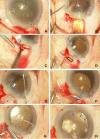Intrascleral Intraocular Lens Fixation Preserving the Lens Capsule in Cases of Cataract with Insufficient Zonular Support
- PMID: 35046634
- PMCID: PMC8761028
- DOI: 10.2147/OPTH.S344523
Intrascleral Intraocular Lens Fixation Preserving the Lens Capsule in Cases of Cataract with Insufficient Zonular Support
Abstract
Purpose: To report our modified simple technique for optic capture and the clinical results of intrascleral IOL fixation preserving the lens capsule, without vitrectomy, in cases of cataract with insufficient zonular support to stabilize the intraocular lens (IOL).
Patients and methods: In 37 eyes of 25 patients with phacodonesis and two or more risk factors for progressive zonular insufficiency, we inserted a CTR to support the capsule and zonules during cataract surgery and IOL fixation; an optic was inserted into the lens capsule, and a haptic was fixed in the scleral tunnel without vitrectomy. In all cases, anterior or total vitrectomy was not needed.
Results: The postoperative mean (± standard deviation) tilt and decentration of the implanted IOL did not change from 6 to 12 months (6.77 ± 3.15° to 6.33 ± 3.38° and 0.60 ± 0.30 to 0.61 ± 0.35 mm, respectively). We encountered no late IOL dislocation and no retinal complications, including retinal breaks or cystoid macular oedema, postoperatively (follow-up = 21.1 ± 5.2 months).
Conclusion: Our modified techniques preclude the need for vitrectomy. If the lens capsule can be preserved using a CTR, our modified technique can be used to stabilize IOL.
Keywords: capsular tension ring; insufficient zonular support; intrascleral IOL fixation; lens capsule; phacodonesis.
© 2022 Kato et al.
Conflict of interest statement
The authors report no conflicts of interest relevant to this work.
Figures


References
LinkOut - more resources
Full Text Sources

